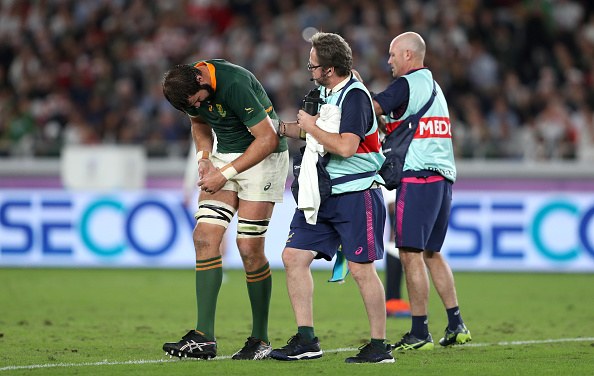Lood de Jager has had to find the strength to overcome a series of serious injuries, which left him questioning his future in the game, writes JON CARDINELLI in the latest SA Rugby magazine.
ALSO READ: What’s in our latest issue?
Rugby players have a reputation for resilience. More than most, Lood de Jager has accepted that serious injuries and long periods of rehabilitation are part and parcel of the game.
After sustaining his first major setback, he threw himself into the recovery programme and promised to return even stronger than before. After the second big injury, he put the doubt aside and got back on the horse.
Later, De Jager pushed through the mental anguish that accompanied the third injury.
At that point, his character as well as his body was tested. After his fourth operation, he started to wonder if this game was for him – a strapping 2.05m, 125kg lock with 45 Test caps and a World Cup winner’s medal to his name. Over a period of several months, he was able to claw his way back from the edge and to regain what he lost.
Even after suffering yet another unlucky break this past April – this time at the Sale Sharks training session before the Champions Cup quarter-finals – he remains positive about the future. Most players would be devastated after sustaining a broken fibula and tearing knee ligaments in a freak training ground accident. De Jager, however, has been through too much and come too far to give up now.
When De Jager spoke to SA Rugby magazine, he reiterated how desperately he would love to represent the Springboks when the world champions return to the international arena. His tone was cheerful and belied the nature of his recent ordeal. He admitted that he is a changed man.
Rewind to May 2020, when we interviewed De Jager about his long run with injuries. At the time, he had just recovered from another shoulder injury, sustained in the 2019 World Cup final.
He described the setback as a fair tradeoff – a World Cup winner’s medal for a gruelling recovery period of four months.
De Jager returned to play only a few minutes for Sale Sharks before the global lockdown in March 2020. He laughed when he was asked about the timing. It was just another case of bad luck.
Then the English Premiership resumed in August. De Jager started to find his feet before he was forced from the field in early September, clutching the same shoulder he injured in Yokohama. Nothing he experienced before could have prepared him for that moment, though.
‘It felt like the end,’ he says. ‘I was sitting in the change room afterwards, crying my eyes out, because I didn’t know what the future would hold for me. Maybe that sounds dramatic … but I was very low.
‘I had come through so many injuries before, but this felt different. I started to ask myself uncomfortable questions. Is my body built for this game? Am I fighting a losing battle?’
After the 2019 World Cup final, De Jager underwent the Latarjet procedure to fix his damaged shoulder. The operation boasts an average success rate in excess of 90%.
Unfortunately, his shoulder was not reattached successfully, which is why he dislocated it again. A subsequent operation in South Africa required a bone graft from his hip – and has since been declared a success.
‘I left the UK shortly after sustaining the injury. I was hoping to get back to SA in time for the birth of my daughter, but she arrived while I was on a layover in Amsterdam. There was nothing I could do about that,’ he says.
Then De Jager was forced to quarantine on his return to South Africa. The time alone in a small hotel room provided him with the chance to face his fears.
He can laugh about it now. ‘I did spend some time feeling sorry for myself,’ he says, ‘but not too long. Ultimately I got my head straight. Then I spent a further two weeks with my family before having the op in early October. That time with my kids gave me a lot of energy for the challenge to come.
‘Suddenly I was excited about rehab and getting back into the swing of things. It was really gruelling at first, with the bones grinding up against the metal. It was painful, but what helped was the fact that I was in the right mental space. The support of my family helped a great deal, as did the support of our medical staff.’
Last year, SA Rugby magazine spoke to Pieter-Steph du Toit about his unfortunate run with injuries. There was a time, in the lead-up to the 2015 World Cup, where the Springbok utility forward was forced to travel to Germany for an experimental procedure on his knee.
Du Toit ended up needing a ligament graft. His father, who travelled with him to Europe, donated his own ligaments to the cause.
Du Toit suffered further setbacks in subsequent years. A freak leg injury sustained while on duty for the Stormers in the 2020 Super Rugby tournament nearly led to the amputation of his leg.
The ordeal shook him to the core – and he was only cleared to return to Stormers training in February this year.
So did De Jager get hold of his Bok teammate for support? If anybody can empathise with De Jager, it’s a man who has endured more than his fair share of trauma.
‘I called Pietie when I got back to SA and went for a braai at his place,’ says De Jager. ‘It was good to speak to someone with such a long history of injuries; who has gone through the same process over and over.
‘Our injuries aren’t the same, but he knows what it takes to come back from a big one. The doctors and your family are key in terms of offering support, but it helps to speak to someone who has been through all the physical and mental challenges. I knew I wasn’t alone – we encouraged one another as best we could.’
De Jager made his comeback for Sale Sharks in late February. New director of rugby Alex Sanderson joked that the Bok lock boasted ‘two metal shoulders’, and that he would be stronger than before. Slowly but surely, his confidence returned.
Then De Jager suffered an unlucky break in the buildup to the Champions Cup quarter-finals. Coaches and teammates heard the bone crack when the Bok lock took contact during a training session.
At the time, his first reaction was to shout “Oh no!” as if he realised what the setback could mean in terms of his prospects with club and country. Several days later, however, De Jager picked himself up and set his sights on another comeback.
‘You can’t turn back time,’ he tells SA Rugby. magazine. ‘You don’t always understand why these things happen. I do believe they happen for a reason, though.
‘My mindset remains the same after coming through my recent shoulder injury. I just need to focus on getting back as soon as possible for the Boks and for Sale.’
Considering everything he’s been through, the challenge of living day-to-day in the frosty climes of northern England is the least of his worries.
‘It’s always raining! But like anything in life, you adapt. It’s got to the point where I no longer notice the cold.
‘I don’t want to make light of lockdown in the UK, but I’ve enjoyed this time with my family. It’s been a chaotic year, with me travelling between SA and the UK, and with the pandemic and my injury. This lockdown has given the four of us the opportunity to spend time together and grow as a family.’
Manchester is a football town. De Jager, a World Cup winner and one of the standout locks in the game, can walk down the street without being hassled by fans.
Another benefit of living in Manchester is the proximity to one of his favourite sporting teams and grounds.
‘I’m a big United fan, and have been since I was a youngster. I can’t abandon them now just when they’re going through a rough patch.
‘I went to watch the Manchester derby last year, right before the first lockdown. United won 2-0. It was a great experience. Hopefully, as things improve, I will have more opportunities to watch them play. I’m going to get some season tickets for Old Trafford as soon as they become available.’
Love them or loathe them, the wet conditions in the northern hemisphere shape the flow of a rugby match. De Jager has learned much since making the move from the Bulls.
‘We’re all about brute force in South Africa. That’s part of our identity, and long may it continue. Up here, they’re more street smart. I call what they do “sleight of hand” … they employ a lot of tricks and short cuts to good effect. What if you could combine brute force with that sleight of hand to become a more complete player? I’m learning every day.’
De Jager hasn’t forgotten what was said in the South African change room almost immediately after the World Cup final in Yokohama. The Boks have set their sights on a series victory against the Lions, and despite the time lost to the pandemic, they won’t want for motivation when the Tests are staged in July and August.
‘It’s a series that’s usually determined by the forwards,’ says De Jager. ‘The Lions will go into that series knowing that they have to nullify the Bok pack to have any chance of winning.
‘They will try to disrupt us in areas like the scrum, maul and lineout. They may even try to take us on and dominate us. I’d be fascinated to see how they approach those particular battles. I’ve got a feeling that they might fight fire with fire. It’s going to be epic.’
De Jager has battled many of those players before. He got the better of Alun Wyn Jones when the Boks defeated Wales in the World Cup semi-final, and bested Maro Itoje and company when South Africa floored England in the final.
The nature of the upcoming Lions series may be different.
‘They’ve got some of the best second rowers in the game. I’m sure those individuals will come into the Tests in the series with a good plan. It will be like nothing we’ve experienced in the past.
‘The Lions will have to adapt after selecting players from the four home unions, though. Even if they pick some combinations along national lines, they will still have to adjust in other positions where some players haven’t combined since the last British & Irish Lions tour in 2017.
‘The Boks, on the other hand, will have the benefit of having played together for long periods,’ he adds. ‘Those combinations have had some success. We’re a tight unit. That chemistry might give us an edge.’
A never-say-die attitude won’t hurt either.





